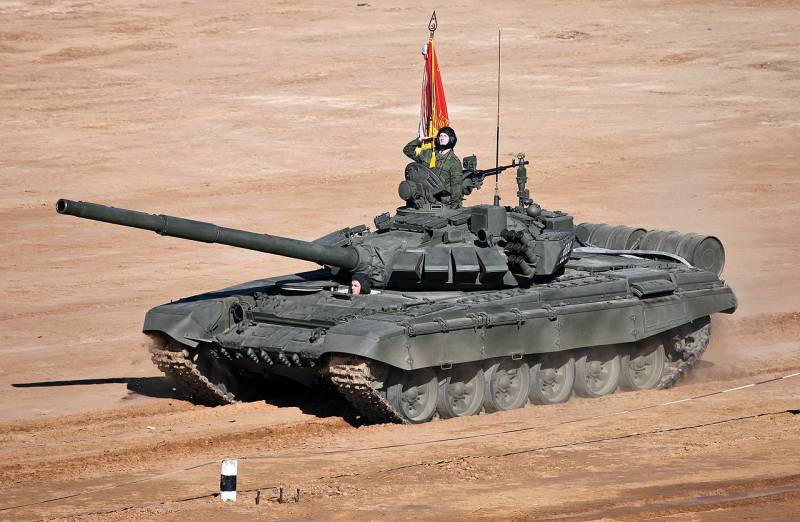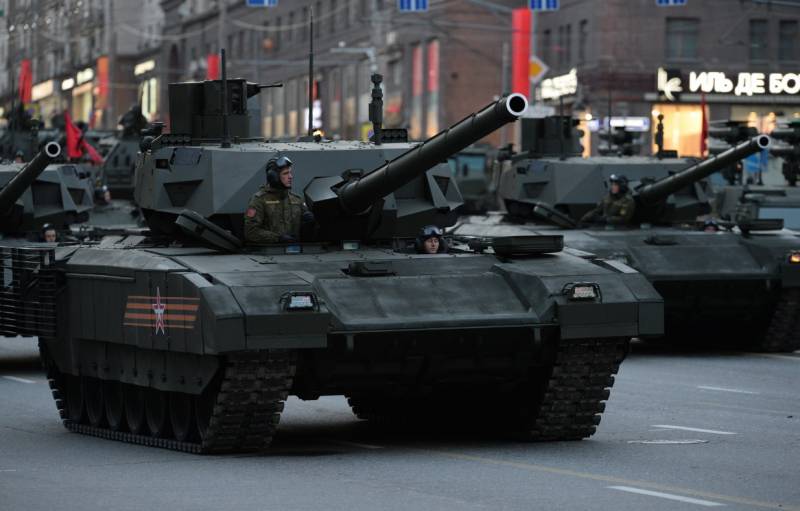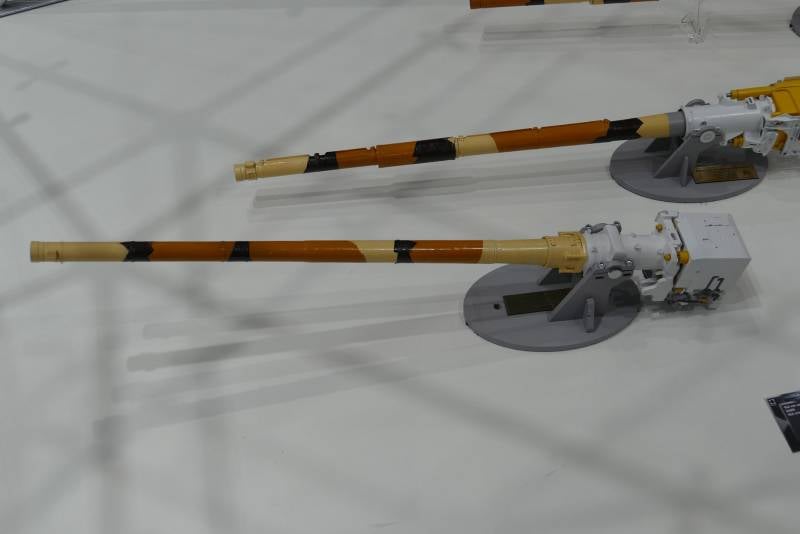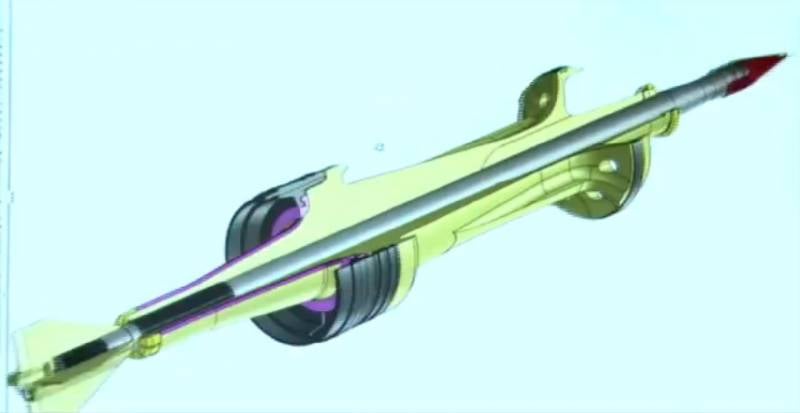Subcaliber shells present and future
The highest characteristics of armor penetration are shown by armor-piercing feathered sabot projectiles (BOPS). Such ammunition appeared a few decades ago, and later proved to be a convenient means of destruction of armored vehicles, which has powerful protection of various types. As a result, at present BOPS are the main tool of tanks for fighting with other tanks. The development of this class of shells continues.
Serial "Mango"
According to various sources, several types of BOPS are currently in service with Russian armored units, and the Mango 3BM-42 product is the most popular representative of this class. The development of a new projectile with increased power under the code "Mango" began in the first half of the eighties. Through the use of certain materials, technologies and solutions should increase armor penetration in comparison with existing projectiles. The future projectile 3BM-42 was supposed to be used with the existing tank guns of the 2А46 family.

The main tank T-72B3 carries an improved automatic loader, compatible with projectiles of increased length. Photo by Vitalykuzmin.net
A few years later, the 3BBM-17 shot with BOPS 3BM-42 came into service. It includes so-called. a burning cylinder inside which the master is rigidly fixed with a projectile. Also for the shot is used a separate partially burning sleeve with ignition means. The cavities of the liner and cylinder are filled with tubular powder, which provides acceleration of the projectile.
The creators of the projectile "Mango" coped with the task of improving armor penetration, and they did it in a very interesting way. The projectile has a special design, due to which the growth of the main characteristics is achieved. At the same time, 3BM-42 outwardly differs almost nothing from other products of its class. This BOPS hollow cylindrical body of small diameter, made of steel and equipped with a tail stabilizer. The front end of the body is closed with a ballistic cap and so-called. armor piercing damper. In the cavity of the body, one after the other, there are two tungsten cores held in place by a low-melting metal shirt.
On the projectile is set dumped master device, made of aluminum. It has a conical shape with an expanding front end. The interaction with the bore is provided by several rings on the outer surface of the device. The 3BBM-17 shot, which includes the cylinder, the projectile and the master, has a length of 574 mm with a diameter of 125 mm. The mass of the projectile itself - 4,85 kg.
Combustion of gunpowder in the sleeve and the cylinder allows you to accelerate the projectile with a master device to a speed of no more than 1700 m / s. After exiting the barrel, the master device is reset. When hit the target, the holding shirt melts, after which the tungsten cores can penetrate the armor. Maximum armor penetration at a distance of 2 km is determined in 500 mm. At an 60 ° meeting angle at the same distance, this characteristic is reduced to 220 mm.
The 3BBM-17 shot with the 3BM-42 projectile was put into service in the 1986 year and significantly affected the combat qualities of all existing main tanks of the Soviet army. This product is still used in tank forces and is almost the basis of their arsenals. Subsequently, the modernization was carried out, which consisted in increasing the length of the hull and cores. As a result, the Mango-M weighs 5 kg and can pierce up to 270 mm of armor at an angle of 60 °.
The long road "Lead"
Shortly after the appearance of BOPS "Mango" in our country began the well-known unpleasant events that hit the mass of spheres, including the development of promising shells for tank guns. Only by the end of the nineties was it possible to get real results in the form of the next projectile with enhanced characteristics. This ammunition was the result of development work with the code "Lead".

Scheme products "Mango". Figure Btvt.narod.ru
Experience has shown that a further increase in the main combat characteristics is associated with an obligatory increase in the length of the projectile. This parameter was brought to the 740 mm, but this fact did not allow the use of the future projectile with the existing tank loading machines. As a result, in the next project of modernization of armored vehicles had to include an update of automation, serving the gun.
In terms of overall appearance, the 3BBM-20 shot with the 3BM-46 “Lead-1” projectile is somewhat similar to the older 3BBM-17 and also consists of a projectile in a burning cylinder and a sleeve with a metal pan. In this case, the design of the projectile itself is very different from the existing one. At this time, it was decided to use a monolithic core of depleted uranium (according to other data, of tungsten alloy), which is actually the basis of the projectile. A ballistic cap and tail stabilizers, the diameter of which is smaller than the caliber of the barrel, are attached to the metal core.
For a longer projectile, an improved master device was created. It has a large length and the presence of two zones of contact. In front of the device there is a large cylinder of the usual look, and the second zone is created by three rear supports. After exiting the barrel such a master device is reset and frees the projectile.

"Mango-M" and a sleeve with a propellant charge. Photo Btvt.narod.ru
According to available data, "Lead-1" has a mass of 4,6 kg and is capable of accelerating to speeds of 1750 m / s. Due to this, he punches up to 650 mm of homogeneous armor at a distance of shot 2000 m and zero meeting angle. It is known about the existence of the project “Lead-2”, which provided for the replacement of the core with a product made from another material. Thus, similar shells from uranium and tungsten could appear in the arsenals.
Due to the long length of the projectile of the new type could not be used with existing automatic loading serial tanks. This problem was solved in the middle of the two thousandth. The T-90A armored vehicles of the new series were completed with modified automatic rifles compatible with “long” projectiles. Subsequently, upgraded T-72B3 began to receive similar equipment. Thus, a significant part of the technique of armored troops can use not only the relatively old "Mango" with limited characteristics.
“Vacuum” for “Almaty”
The observed increase in the protection characteristics of the potential enemy’s tanks is a real challenge for weapons developers. Further research work led to conclusions about the need for a new increase in the length of the munition. The optimal ratio of characteristics could show BOPS 1000 mm long, but such a projectile, for obvious reasons, could not be used with the 2А46 gun and its automatic loader.

Projectile 3BM-46 with a master device. Photo Fofanov.armor.kiev.ua
The way out of this situation was the creation of a completely new instrument with additional equipment. A promising gun later became known under the symbol 2А82, and the new projectile received the code "Vacuum". From a certain time, the new armament complex began to be considered in the context of the project of the promising tank “Armata”. In case of successful completion of the work on the gun and the BOPS, the new tank could get them as the main weapon.
According to some sources, the project "Vacuum" turned in favor of new developments. In connection with the beginning of the development of the 2А82-1М instrument, instead of such a projectile, it was proposed to create a smaller BOPS with the “Vacuum-1” cipher. It was supposed to have a length of “total” 900 mm and be fitted with a carbide core. In the recent past, representatives of the defense industry mentioned that organizations from Rosatom were involved in the development of a new projectile. Their participation is due to the use of depleted uranium.
According to some reports, a projectile called Vacuum 2 is being created in parallel. By design, it should be similar to the product with the unit, but it is different material. It is proposed to make a tungsten alloy, more familiar to domestic BOPS. Also for use with the 2А82-М instrument are high-explosive fragmentation munitions with controlled explosions with the code “Telnik” and the 3UBK21 “Sprinter” guided missile. Exact information about creating a new 125-mm cumulative projectile is not yet available.
The appearance and exact technical characteristics of the perspective BOPS of the “Vacuum” family have not yet been specified. It is only known that a projectile with a uranium core will pierce the order of 900-1000 mm homogeneous armor. Probably, such characteristics can be obtained at an ideal angle of impact. No other details.
Perspective "Slate"
According to various reports of past years, promising domestic-made tanks were also supposed to receive an armor-piercing projectile called the Slate. However, there was not too much information about him, which led to confusion and errors. So, for some time it was believed that the "Slate" is intended for new 125-mm guns. Now it is known that this product is planned to be used with a more powerful 2A83 gun of 152 mm caliber.
Apparently, the projectile for high-power guns in its appearance will be similar to other members of its class. It will receive a large elongation core, equipped with a ballistic cap and an armor-piercing damper in the head part, as well as a stabilizer of a relatively small caliber. Earlier it was reported that the projectiles "Slate-1" and "Slate-2" will be equipped with tungsten and uranium cores. In this case, any data on the parameters of armor penetration of new projectiles are missing.
According to various estimates, based on the caliber and the estimated energy indicators, the “leads” will be able to penetrate at least 1000-1200 mm of homogeneous armor at the optimum angle of impact. However, there are information about some of the typical problems in the development of such ammunition. Due to certain objective limitations, the energy efficiency of the shot for the 152-mm guns may be lower than for systems of smaller caliber. Whether it will be possible to cope with such problems and to fully use the energy reserve of the propellant charge is unknown.
A promising tank gun 2А83 is currently being developed in the context of the further development of the Armat’s unified tracked platform. The already created main tank T-14 is equipped with an uninhabited turret with an 2-82-1-gun. In the foreseeable future, a new version of the tank is expected, featuring a different combat compartment and a more powerful 2-83 gun. Together with them, the improved "Armata" will also receive the BOPS of the "Grimel" line.
Shells present and future
Currently, the armored forces have several armor-piercing feathered sub-caliber shells intended for use with instruments of the rather old but successful 2-46 line. A significant part of the main tanks of existing models has a relatively old automatic loading, and therefore can only use the shells "Mango" and older products. At the same time, the later series T-90A tanks, as well as the upgraded T-72B3 tanks, are equipped with improved automatic loaders, due to which relatively long shells of the Lead line can be used.
BOPS 3BM-42 and 3БМ-46 have high enough characteristics, and thanks to this they are able to fight a wide range of targets present on the battlefield. At the same time, sub-caliber ammunition is not the only means of fighting enemy tanks. For the same purpose, our tanks can use guided missiles and cumulative shots. Thus, "Mango", "Lead" and other tank ammunition provide combat against various targets in a wide range of ranges.
The next generation of Russian tanks, while represented only by the Armata T-14, is equipped with a new 2A82-1М, which shows higher performance and is compatible with new ammunition. The new family of shells and rockets will provide a noticeable increase in combat qualities and is fully capable of bringing Armata to the leading position in the world.
It is no secret that in the recent past there has been a significant backlog of domestic BOPS from modern foreign samples. However, the situation is gradually changing, and new models of this kind are coming into service. In the foreseeable future, armored units will receive fundamentally new combat vehicles with modern weapons and ammunition. There is every reason to believe that the gap will at least narrow. Moreover, we cannot exclude the possibility of advancing foreign competitors with clear consequences for the combat capability of the army.
On the materials of the sites:
http://vpk.mane/
http://ria.ru/
http://tass.ru/
http://otvaga2004.ru/
http://btvt.narod.ru/
http://russianarms.ru/
http://fofanov.armor.kiev.ua/
http://gurkhan.blogspot.com/
http://bmpd.livejournal.com/




Information